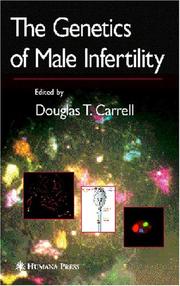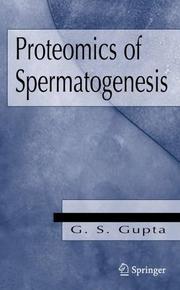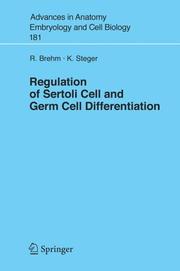| Listing 1 - 10 of 11 | << page >> |
Sort by
|
Book
ISBN: 1634847261 9781634847261 9781634847155 1634847156 Year: 2016 Publisher: New York : Nova Biomedical,
Abstract | Keywords | Export | Availability | Bookmark
 Loading...
Loading...Choose an application
- Reference Manager
- EndNote
- RefWorks (Direct export to RefWorks)
Spermatogenesis. --- Formation of spermatozoa --- Spermatozoa --- Gametogenesis --- Formation

ISBN: 1280832541 9786610832545 1597451762 1588298639 Year: 2007 Publisher: Totowa, N.J. : Humana Press,
Abstract | Keywords | Export | Availability | Bookmark
 Loading...
Loading...Choose an application
- Reference Manager
- EndNote
- RefWorks (Direct export to RefWorks)
Infertility is a common and severe health problem affecting roughly 7% of the male population. It is likely that the majority of those patients have genetic abnormalities that are the cause of their infertility. In The Genetics of Male Infertility, twenty-one researchers and clinicians review the study of the genetics of male infertility, the tools available in the laboratory and clinic, the current state of knowledge, and the future of research and translation into clinical diagnostics and treatments. This volume gives special attention to the significant technological advances in the treatment of male infertility, including intracytoplasmic injection (ICSI) in conjunction with in vitro fertilization (IVF). In addition, new tools discussed include in vitro methodologies, in silico technologies, and new model organisms. Providing a review of our current understanding of genetic causes of male infertility, The Genetics of Male Infertility serves as a guide to evidence-based clinical applications, and a preview of future possibilities.
Infertility, Male --- Spermatogenesis --- Genetic aspects --- Formation of spermatozoa --- Spermatozoa --- Gametogenesis --- Male infertility --- Male sterility --- Sterility, Male --- Generative organs, Male --- Infertility --- Formation --- Diseases
Periodical
Abstract | Keywords | Export | Availability | Bookmark
 Loading...
Loading...Choose an application
- Reference Manager
- EndNote
- RefWorks (Direct export to RefWorks)
Spermatogenesis --- Cellular control mechanisms --- Cellular control mechanisms. --- Genetic aspects --- Genetic aspects. --- Genetics --- Cell regulation --- Biological control systems --- Cell metabolism --- Formation of spermatozoa --- Spermatozoa --- Gametogenesis --- Formation --- Spermatogenesis. --- Spermatocytogenesis --- Spermiogenesis

ISBN: 1281087238 9786611087234 0387276556 038725398X Year: 2005 Publisher: New York, NY : Springer US : Imprint: Springer,
Abstract | Keywords | Export | Availability | Bookmark
 Loading...
Loading...Choose an application
- Reference Manager
- EndNote
- RefWorks (Direct export to RefWorks)
Recent developments of experimental techniques in cellular and molecular biology have made it possible to understand the molecular biology of male gametogenesis in greater detail. This book focuses on the description of specialized proteins, which are dominantly and/or specifically expressed in germ cells and localized in spermatozoa. There is an urgent need to classify proteins of spermatogenic cells with a view of their functions, and their applications in the regulation of fertility and in understanding infertility. The understanding of structural properties of male germ cell specific proteins can offer vulnerable points for targeted intervention in testis without generalized effects on stages of spermatogenesis. Besides targeted action in male germ cells, sperm specific proteins and polypeptides may also offer potential application in the development of a contraceptive vaccine. Researchers in the fields of biochemistry, cell biology, molecular biology, reproductive biology and proteomics will find this book of interest. "This book is far superior to any previous book on the subject. I recommend this book with great enthusiasm." Pawan K. Singal St. Boniface General Hospital Research Center .
Spermatogenesis. --- Proteomics. --- Molecular biology --- Proteins --- Formation of spermatozoa --- Spermatozoa --- Gametogenesis --- Formation --- Cytology. --- Cell Biology. --- Cell biology --- Cellular biology --- Biology --- Cells --- Cytologists --- Cell biology. --- Proteins. --- Protein Biochemistry. --- Proteids --- Biomolecules --- Polypeptides --- Proteomics
Book
ISBN: 1281928496 9786611928490 0080919871 0123725682 Year: 2009 Publisher: London : Elsevier/Academic Press,
Abstract | Keywords | Export | Availability | Bookmark
 Loading...
Loading...Choose an application
- Reference Manager
- EndNote
- RefWorks (Direct export to RefWorks)
This book represents the first analysis of the evolutionary significance of sperm phenotypes and derived sperm traits and the possible selection pressures responsible for sperm-egg coevolution.An understanding of sperm evolution is fast developing and promises to shed light on many topics from basic reproductive biology to the evolutionary process itself as well as the sperm proteome, the sperm genome and the quantitative genetics of sperm. The Editors have identified 15 topics of current interest and biological significance to cover all aspects of this bizarre, fascinating and importa
Spermatozoa. --- Spermatogenesis. --- Evolution (Biology) --- Animal evolution --- Animals --- Biological evolution --- Darwinism --- Evolutionary biology --- Evolutionary science --- Origin of species --- Biology --- Evolution --- Biological fitness --- Homoplasy --- Natural selection --- Phylogeny --- Formation of spermatozoa --- Spermatozoa --- Gametogenesis --- Male gametes --- Sperm --- Gametes --- Semen --- Formation
Book
ISBN: 9780511975943 9780521880954 9780521707374 9781139076999 113907699X 9781139079273 1139079271 0521880955 1107218993 1139062638 1283112949 9786613112941 1139074741 1139068962 0511975945 1139081551 Year: 2011 Publisher: Cambridge : Cambridge University Press,
Abstract | Keywords | Export | Availability | Bookmark
 Loading...
Loading...Choose an application
- Reference Manager
- EndNote
- RefWorks (Direct export to RefWorks)
Darwin identified the existence of separate male and female gametes as one of the central mysteries of evolutionary biology. 150 years later, the question of why male gametes exist remains an intriguing puzzle. In this, the first book solely devoted to the evolution of anisogamy, top theorists in the field explore why gamete dimorphism characterizes nearly all plants and animals. Did separate male and female gametes evolve as a result of competition, or does anisogamy instead represent selection for cooperation? If disruptive selection drove the evolution of anisogamy, with male gametes focused on search and fusion, and female gametes provisioning the new zygote, why do some algal species continue to produce gametes of a single size? Does sperm limitation, or escape from infection, better explain the need for extremely small, highly mobile sperm? Written by leaders in the field, this volume offers an authoritative and cutting-edge overview of evolutionary theory.
Gametes --- Gametogenesis. --- Natural selection. --- Plants --- Reproduction, Asexual. --- Asexual reproduction --- Gemmation (Zoology) --- Spores --- Gemmation (Botany) --- Plant reproduction --- Plant physiology --- Reproduction --- Plants, Sex in --- Plant spores --- Darwinism --- Selection, Natural --- Genetics --- Variation (Biology) --- Biological invasions --- Evolution (Biology) --- Heredity --- Formation of gametes --- Cell differentiation --- Germ cells --- Evolution. --- Reproduction. --- Formation

ISBN: 1280346833 9786610346837 3540294465 3540257500 Year: 2005 Publisher: Berlin, Heidelberg : Springer Berlin Heidelberg : Imprint: Springer,
Abstract | Keywords | Export | Availability | Bookmark
 Loading...
Loading...Choose an application
- Reference Manager
- EndNote
- RefWorks (Direct export to RefWorks)
Unwanted childlessness affects approximately one in six couples worldwide. - though the exact proportion of the predominant cause of the problem remains controversial, according to the World Health Organization (WHO), in nearly 40% of cases the cause can be attributed to the female, in 20% to the male, in 25% to both, and in 15% the cause remains unknown. Based on these ?gures, the - cidence of male factor infertility in the general population is approximately 7%. The majority of these men, approximately 30%, experience irreversible idiopathic infertility and cannot father children without some form of medical intervention. Male factor infertility, in addition, may be caused by testicular germ cell cancer, which is known to represent the most common cancer among young men, aged 15 to 35 years, in Western industrialized countries. The number of affected men has increased dramatically over the past 50 years. There is now growing evidence that human testicular germ cell cancer originates from fetal germ cells exhibiting an aberrant programme of gene expression, and tumour progression may be favoured by an aberrant Sertoli cell-germ cell communication.
Sertoli cells. --- Germ cells. --- Spermatogenesis. --- Infertility, Male. --- Male infertility --- Male sterility --- Sterility, Male --- Generative organs, Male --- Infertility --- Formation of spermatozoa --- Spermatozoa --- Gametogenesis --- Gametocytes --- Germ-line cells --- Germline --- Reproductive cells --- Sex cells --- Cells --- Germplasm resources --- Cells of Sertoli --- Sertoli's cells --- Sustentacular cells --- Testis --- Diseases --- Formation --- Medicine. --- Biomedicine general. --- Clinical sciences --- Medical profession --- Human biology --- Life sciences --- Medical sciences --- Pathology --- Physicians --- Health Workforce --- Biomedicine, general. --- Medicine --- Biology --- Biomedical Research. --- Research. --- Biological research --- Biomedical research
Book
ISBN: 0387095977 3540095977 0387799907 1489981454 0387095969 Year: 2008 Publisher: New York, NY : Springer New York : Imprint: Springer,
Abstract | Keywords | Export | Availability | Bookmark
 Loading...
Loading...Choose an application
- Reference Manager
- EndNote
- RefWorks (Direct export to RefWorks)
In the past thirty years, significant advances have been made in the field of reproductive biology in unlocking the molecular and biochemical events that regulate spermatogenesis in the mammalian testis. It was possible because of the unprecedented breakthroughs in molecular biology, cell biology, immunology, and biochemistry. In this book entitled, Molecular Mechanisms in Spermatogenesis, a collection of chapters has been included written by colleagues on the latest development in the field using genomic and proteomic approaches to study spermatogenesis, as well as different mechanisms and/or molecules including environmental toxicants and transcription factors that regulate and/or affect spermatogenesis. The book begins with a chapter that provides the basic concept of cellular regulation of spermatogenesis. A few chapters are also dedicated to some of the latest findings on the Sertoli cell cytoskeleton and other molecules (e.g., proteases, adhesion proteins) that regulate spermatogenesis. These chapters contain thought-provoking discussions and concepts which shall be welcomed by investigators in the field. It is obvious that many of these concepts will be updated and some may be amended in the years to come. However, they will serve as a guide and the basis for investigation by scientists in the field.
Spermatogenesis. --- Testis --- Molecular aspects. --- Testes --- Testicle --- Endocrine glands --- Generative organs, Male --- Gonads --- Scrotum --- Formation of spermatozoa --- Spermatozoa --- Gametogenesis --- Formation --- 537.8 --- 537.8 Electromagnetism. Electromagnetic field. Electrodynamics. Maxwell theory --- Electromagnetism. Electromagnetic field. Electrodynamics. Maxwell theory --- Medicine. --- Molecular Medicine. --- Biomedicine general. --- Clinical sciences --- Medical profession --- Human biology --- Life sciences --- Medical sciences --- Pathology --- Physicians --- Molecular biology. --- Biomedicine, general. --- Health Workforce --- Molecular biochemistry --- Molecular biophysics --- Biochemistry --- Biophysics --- Biomolecules --- Systems biology
Periodical
ISSN: 13484400 09168818 Year: 1992 Publisher: [Tokyo] : Japanese Society of Animal Reproduction,
Abstract | Keywords | Export | Availability | Bookmark
 Loading...
Loading...Choose an application
- Reference Manager
- EndNote
- RefWorks (Direct export to RefWorks)
Reproduction --- Developmental biology --- Developmental Biology. --- Reproduction. --- Developmental biology. --- Voortplanting (biologie) --- Amphimixis --- Generation --- Pangenesis --- Procreation --- Development (Biology) --- Human Reproductive Index --- Human Reproductive Indexes --- Reproductive Period --- Human Reproductive Indices --- Index, Human Reproductive --- Indexes, Human Reproductive --- Indices, Human Reproductive --- Period, Reproductive --- Periods, Reproductive --- Reproductive Index, Human --- Reproductive Indices, Human --- Reproductive Periods --- Biology, Developmental --- Biology --- Life (Biology) --- Physiology --- Sex (Biology) --- Embryology --- Generative organs --- Theriogenology --- Growth --- Ontogeny --- Embryonic and Fetal Development --- Growth and Development --- Agriculture Sciences --- Agricultural Biotechnology --- Auxology --- gametogenesis --- early embryonic development --- placenta development --- implantation --- reproductive endocrine function --- reproductive organ development --- Reproducción --- Biología del desarrollo --- Biologie du développement
Book
Year: 2021 Publisher: Basel, Switzerland MDPI - Multidisciplinary Digital Publishing Institute
Abstract | Keywords | Export | Availability | Bookmark
 Loading...
Loading...Choose an application
- Reference Manager
- EndNote
- RefWorks (Direct export to RefWorks)
A cross-disciplinary approach is offered to consider the challenge of emerging technologies designed to enhance human bodies and minds. Perspectives from philosophy, ethics, law, and policy are applied to a wide variety of enhancements, including integration of technology within human bodies, as well as genetic, biological, and pharmacological modifications. Humans may be permanently or temporarily enhanced with artificial parts by manipulating (or reprogramming) human DNA and through other enhancement techniques (and combinations thereof). We are on the cusp of significantly modifying (and perhaps improving) the human ecosystem. This evolution necessitates a continuing effort to re-evaluate current laws and, if appropriate, to modify such laws or develop new laws that address enhancement technology. A legal, ethical, and policy response to current and future human enhancements should strive to protect the rights of all involved and to recognize the responsibilities of humans to other conscious and living beings, regardless of what they look like or what abilities they have (or lack). A potential ethical approach is outlined in which rights and responsibilities should be respected even if enhanced humans are perceived by non-enhanced (or less-enhanced) humans as “no longer human” at all.
cyborgs --- implants --- posthumans --- Homo technologicus --- Homo sapiens --- human-machine interaction --- cyborg --- enhancement technology --- prosthesis --- brain–computer interface --- new senses --- identity --- neuroprosthesis --- patent law --- copyright law --- cognitive liberty --- international law --- evolution --- cultural technology --- human enhancement --- engineering --- bionics --- biotechnology --- disability --- marketing --- cultural studies --- Disney --- supercrip --- human enhancements --- autonomy --- informed consent --- moral enhancement --- vulnerability --- numeric identity --- military ethics --- human–machine interaction --- upgrading humans --- superhumans --- gene editing --- embryo selection --- CRISPR --- cognitive enhancement --- assisted reproductive technologies (ART) --- public opinion --- in vitro gametogenesis (IVG) --- genome-wide association studies (GWAS) --- brain–computer interface (BCI) --- brain–machine interface (BMI) --- ethical --- legal and social Issues (ELSI) --- neuroethics --- narrative review --- intellectual property --- copyright --- neuropolitics --- brain science --- voting --- human rights --- ethics --- discrimination --- racism --- speciesism --- ableism --- human–robot interaction --- mind --- sense of agency --- alienation --- n/a --- brain-computer interface --- brain-computer interface (BCI) --- brain-machine interface (BMI) --- human-robot interaction
| Listing 1 - 10 of 11 | << page >> |
Sort by
|

 Search
Search Feedback
Feedback About
About Help
Help News
News